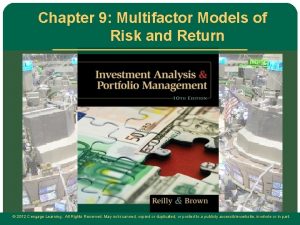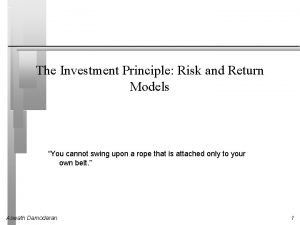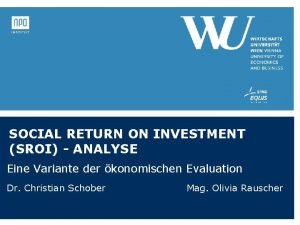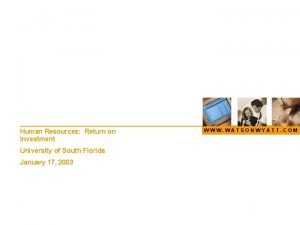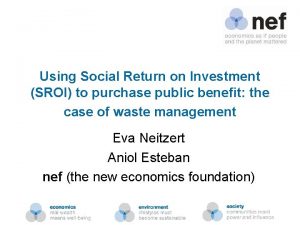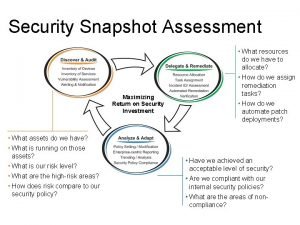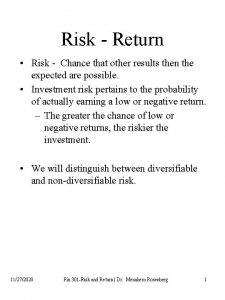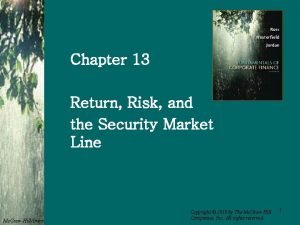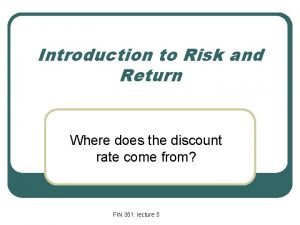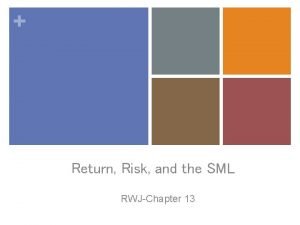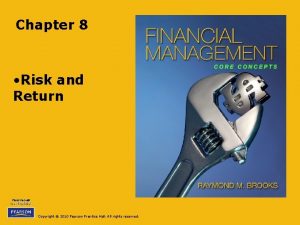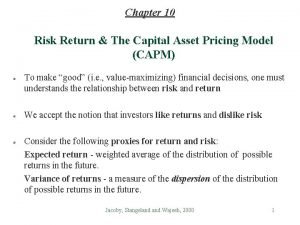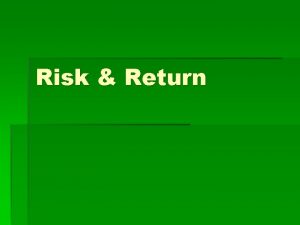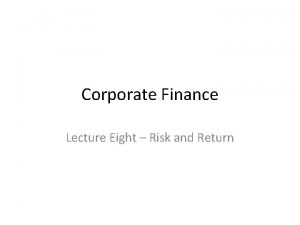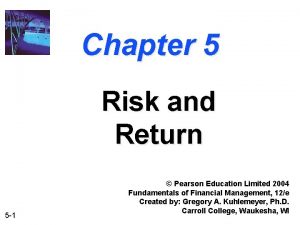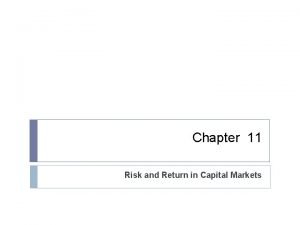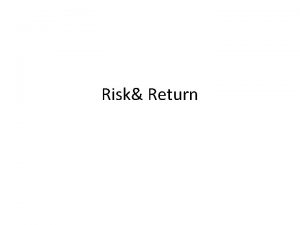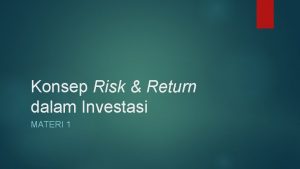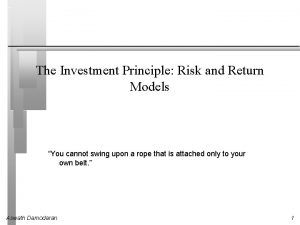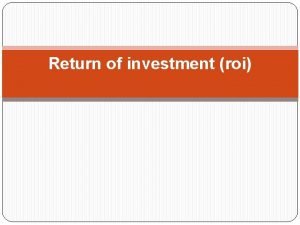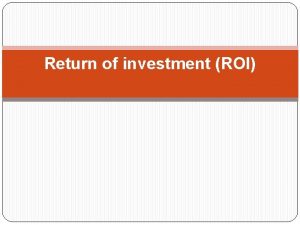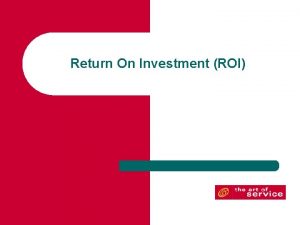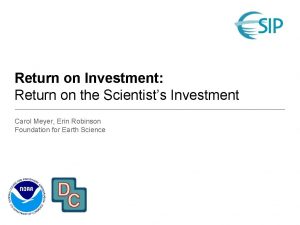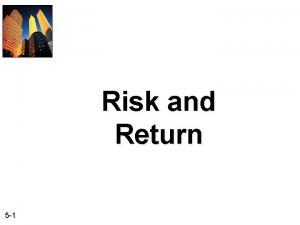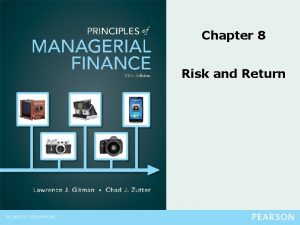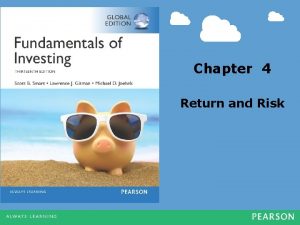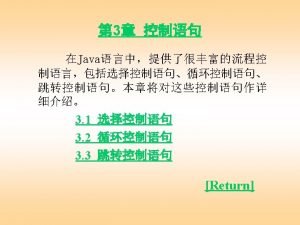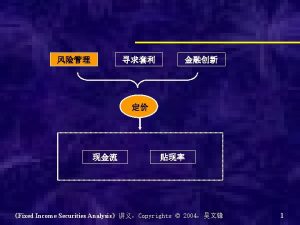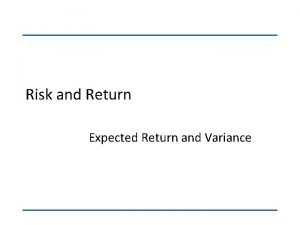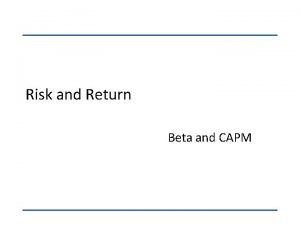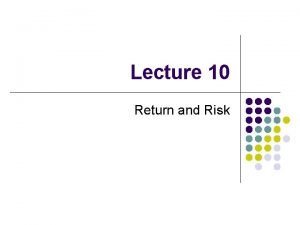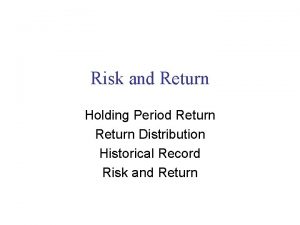The Investment Principle Risk and Return Models You


























- Slides: 26

The Investment Principle: Risk and Return Models “You cannot swing upon a rope that is attached only to your own belt. ” Aswath Damodaran 1

First Principles Aswath Damodaran 2

The notion of a benchmark Since financial resources are finite, there is a hurdle that projects have to cross before being deemed acceptable. This hurdle will be higher for riskier projects than for safer projects. A simple representation of the hurdle rate is as follows: Hurdle rate = Riskless Rate + Risk Premium The two basic questions that every risk and return model in finance tries to answer are: • • Aswath Damodaran How do you measure risk? How do you translate this risk measure into a risk premium? 3

What is Risk? Risk, in traditional terms, is viewed as a ‘negative’. Webster’s dictionary, for instance, defines risk as “exposing to danger or hazard”. The Chinese symbols for risk, reproduced below, give a much better description of risk The first symbol is the symbol for “danger”, while the second is the symbol for “opportunity”, making risk a mix of danger and opportunity. You cannot have one, without the other. Aswath Damodaran 4

A good risk and return model should… 1. It should come up with a measure of risk that applies to all assets and not be asset-specific. 2. It should clearly delineate what types of risk are rewarded and what are not, and provide a rationale for the delineation. 3. It should come up with standardized risk measures, i. e. , an investor presented with a risk measure for an individual asset should be able to draw conclusions about whether the asset is above-average or below-average risk. 4. It should translate the measure of risk into a rate of return that the investor should demand as compensation for bearing the risk. 5. It should work well not only at explaining past returns, but also in predicting future expected returns. Aswath Damodaran 5

The Capital Asset Pricing Model Uses variance of actual returns around an expected return as a measure of risk. Specifies that a portion of variance can be diversified away, and that is only the non-diversifiable portion that is rewarded. Measures the non-diversifiable risk with beta, which is standardized around one. Translates beta into expected return Expected Return = Riskfree rate + Beta * Risk Premium Works as well as the next best alternative in most cases. Aswath Damodaran 6

The Mean-Variance Framework The variance on any investment measures the disparity between actual and expected returns. Low Variance Investment High Variance Investment Expected Return Aswath Damodaran 7

How risky is Disney? A look at the past… Aswath Damodaran 8

Do you live in a mean-variance world? Assume that you had to pick between two investments. They have the same expected return of 15% and the same standard deviation of 25%; however, investment A offers a very small possibility that you could quadruple your money, while investment B’s highest possible payoff is a 60% return. Would you a. be indifferent between the two investments, since they have the same expected return and standard deviation? b. prefer investment A, because of the possibility of a high payoff? c. prefer investment B, because it is safer? Would your answer change if you were not told that there is a small possibility that you could lose 100% of your money on investment A but that your worst case scenario with investment B is -50%? Aswath Damodaran 9

The Importance of Diversification: Risk Types Aswath Damodaran 10

The Effects of Diversification Firm-specific risk can be reduced, if not eliminated, by increasing the number of investments in your portfolio (i. e. , by being diversified). Market-wide risk cannot. This can be justified on either economic or statistical grounds. On economic grounds, diversifying and holding a larger portfolio eliminates firm-specific risk for two reasons(a) Each investment is a much smaller percentage of the portfolio, muting the effect (positive or negative) on the overall portfolio. (b) Firm-specific actions can be either positive or negative. In a large portfolio, it is argued, these effects will average out to zero. (For every firm, where something bad happens, there will be some other firm, where something good happens. ) Aswath Damodaran 11

A Statistical Proof that Diversification works… An example with two stocks. . Aswath Damodaran 12

The variance of a portfolio… Aswath Damodaran 13

A caveat on diversification: The lessons of 2008 Diversification reduces exposure to risks that are uncorrelated. It cannot eliminate your exposure to correlated risks. Two phenomena are undercutting the effectiveness of diversification: • Globalization: As companies and investors globalize, the correlation across global economies and markets is increasing. The benefits to diversification are therefore dropping. • Securitization: As more and more asset classes become securitized (accounts receivable, mortgages, commodities…), the correlation across asset classes is increasing. When there is a crisis of confidence and investors become more risk averse, the correlation across all risky assets increases, thus undercutting the benefits of diversification when you need it the most. Aswath Damodaran 14

The Role of the Marginal Investor The marginal investor in a firm is the investor who is most likely to be the buyer or seller on the next trade and to influence the stock price. Generally speaking, the marginal investor in a stock has to own a lot of stock and also trade a lot. Since trading is required, the largest investor may not be the marginal investor, especially if he or she is a founder/manager of the firm (Michael Dell at Dell Computers or Bill Gates at Microsoft) In all risk and return models in finance, we assume that the marginal investor is well diversified. Aswath Damodaran 15

Identifying the Marginal Investor in your firm… Aswath Damodaran 16

Analyzing the investor bases… Aswath Damodaran 17

Looking at Disney’s top stockholders in 2009 (again) Aswath Damodaran 18

And the top investors in Deutsche and Aracruz… Aswath Damodaran 19

Taking a closer look at Tata Chemicals… Aswath Damodaran Tata companies and trusts: 31. 6% Institutions & Funds: 34. 68% Foreign Funds: 5. 91% 20

The Market Portfolio Assuming diversification costs nothing (in terms of transactions costs), and that all assets can be traded, the limit of diversification is to hold a portfolio of every single asset in the economy (in proportion to market value). This portfolio is called the market portfolio. Individual investors will adjust for risk, by adjusting their allocations to this market portfolio and a riskless asset (such as a T-Bill) Preferred risk level No risk Some risk A little more risk Even more risk A risk hog. . Allocation decision 100% in T-Bills 50% in T-Bills; 50% in Market Portfolio; 25% in T-Bills; 75% in Market Portfolio 100% in Market Portfolio Borrow money; Invest in market portfolio Every investor holds some combination of the risk free asset and the market portfolio. Aswath Damodaran 21

The Risk of an Individual Asset The risk of any asset is the risk that it adds to the market portfolio Statistically, this risk can be measured by how much an asset moves with the market (called the covariance) Beta is a standardized measure of this covariance, obtained by dividing the covariance of any asset with the market by the variance of the market. It is a measure of the non-diversifiable risk for any asset can be measured by the covariance of its returns with returns on a market index, which is defined to be the asset's beta. The required return on an investment will be a linear function of its beta: Expected Return = Riskfree Rate+ Beta * (Expected Return on the Market Portfolio Riskfree Rate) Aswath Damodaran 22

Limitations of the CAPM 1. The model makes unrealistic assumptions 2. The parameters of the model cannot be estimated precisely - Definition of a market index - Firm may have changed during the 'estimation' period' 3. The model does not work well - If the model is right, there should be a linear relationship between returns and betas the only variable that should explain returns is betas - The reality is that the relationship between betas and returns is weak Other variables (size, price/book value) seem to explain differences in returns better. Aswath Damodaran 23

Alternatives to the CAPM Aswath Damodaran 24

Why the CAPM persists… The CAPM, notwithstanding its many critics and limitations, has survived as the default model for risk in equity valuation and corporate finance. The alternative models that have been presented as better models (APM, Multifactor model. . ) have made inroads in performance evaluation but not in prospective analysis because: • • • Aswath Damodaran The alternative models (which are richer) do a much better job than the CAPM in explaining past return, but their effectiveness drops off when it comes to estimating expected future returns (because the models tend to shift and change). The alternative models are more complicated and require more information than the CAPM. For most companies, the expected returns you get with the alternative models is not different enough to be worth the extra trouble of estimating four additional betas. 25

6 Application Test: Who is the marginal investor in your firm? You can get information on insider and institutional holdings in your firm from: http: //finance. yahoo. com/ Enter your company’s symbol and choose profile. Looking at the breakdown of stockholders in your firm, consider whether the marginal investor is An institutional investor b) An individual investor c) An insider a) Aswath Damodaran 26
 Multifactor model of risk and return
Multifactor model of risk and return Risk return principle
Risk return principle Liquidity measures
Liquidity measures Fixed investment and inventory investment
Fixed investment and inventory investment Sroi analyse
Sroi analyse Human resources return on investment
Human resources return on investment Required return on investment formula
Required return on investment formula Sroi
Sroi Return on security investment
Return on security investment Internal communication return on investment
Internal communication return on investment Systems engineering return on investment
Systems engineering return on investment Risk and return
Risk and return The risk per unit of return is measured by the
The risk per unit of return is measured by the Risk and return
Risk and return Financial management chapter 8 risk and return
Financial management chapter 8 risk and return Chapter 13 return risk and the security market line
Chapter 13 return risk and the security market line Introduction to risk and return
Introduction to risk and return Risk and return
Risk and return Chapter 8 risk and rates of return problem solutions
Chapter 8 risk and rates of return problem solutions Calculate expected portfolio return
Calculate expected portfolio return Contoh soal risk and return
Contoh soal risk and return Difference between risk and return
Difference between risk and return Chapter 5 risk and return
Chapter 5 risk and return Difference between risk and return
Difference between risk and return Risk and return
Risk and return Konsep risk and return
Konsep risk and return What is the difference between modals and semi modals?
What is the difference between modals and semi modals?
